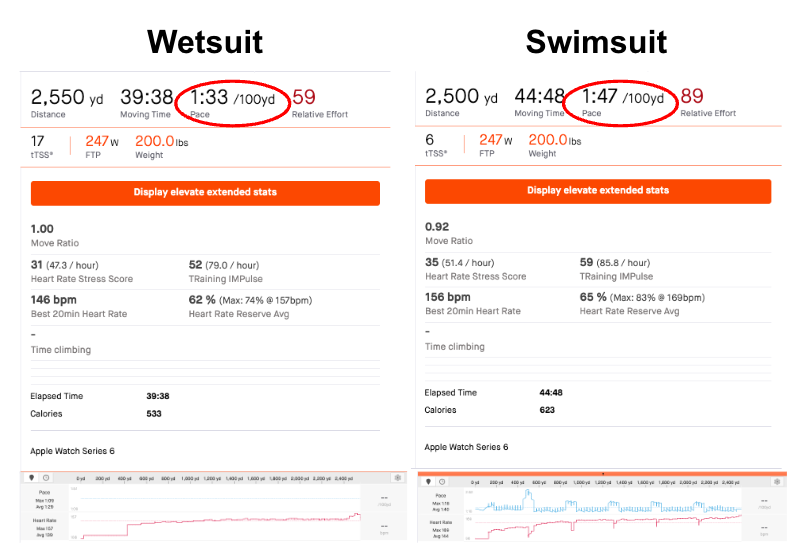With a lot of time and effort, not to mention money, recently spent trying to train for a triathlon one commonly suggested way to buy some improvement has been a wetsuit. In meeting with my triathlon coach (check out the experience with a coach we wrote up here), she noted that I would “feel sooo fast” with a wetsuit.
Even though the primary race I am training for is done in 72deg F water, the benefits in comfort and buoyancy are well understood. Our test results, shown in detail below, confirmed our coaches suspicion and showed that a wetsuit was as good as a few months of solid swim training in terms of how much improvement to expect.
After a bit of shopping around I settled on the BlueSeventy full body sprint suit. I figured whatever buoyancy impact I got would help when extended to the arms, and in the event I wanted to use it in full surf, colder weather, or other swims this suit would be sufficient.
Once the suit came the next step was to test it out. Everyone who has raced triathlons, and many other endurance events, has likely heard the adage “nothing new on race day”. So, after peeling the suit on in a mirror to make sure the size wasn’t terrible the next step was to plan a race-like workout day.
My training plan called for a 40 minute endurance swim which is a standard workout and one I had done exactly a month prior. With the benefit of being able to compare the two workouts ahead, I set out to the pool to test the race day setup.
Other than the wetsuit the other addition was a cap. As a man with short hair most of my training swims are done without a cap for ease. But in order to ensure goggles could stay on, and in the spirit of matching what I would wear on race day it was an obvious addition.
Other than the suit I tracked the workout with and Apple Watch for swimming, which I plan to track on race day. The only missing component was an ankle timing chip that the race would provide.
How Much Faster Is A Wetsuit – BlueSeventy Wetsuit vs Jammer Swim Suit
Most folks reading this will want to understand how much faster a wetsuit is than a swimsuit. In our estimation from comparing two similar swims the wetsuit was around 10-13% faster overall.
This equated to rough reduction is average time/100 yards from 1:47 down to 1:33. Savings of 14 seconds/100 (possibly less to to workout differences) would result in a faster Olympic distance triathlon swim improvements of 3-4 minutes!
It is true that no two workouts are the same. These swims were done exactly one month apart from each other with the slower (swim suit) done prior to wetsuit. In between there was a lot of biking and running, but only 4 total swim workouts totaling 6700 yards. This level of effort also led to being lower in body weight by 1-2% (or around 2-3 pounds).
All of this benefits the slower pace, as does the setup of the workout. The bathing suit swim was done as 400-500 yard swims with 15 seconds rest in between. While this does slow things down it should also benefit by lowering heart rate, which was also tracked. The ease of gliding with the wetsuit helped a lot here though with the average heart rate with a swim suit being 10-15 BPM higher at any moment than when wearing a wetsuit.

Related to the training plan this puts the swim in an entirely different heart rate zone. Said differently, the benefit of the wetsuit for heart rate in a triathlon is the difference between starting the bike with a decent warmup vs. starting the bike already tired with a solid workout under your belt.
There was plenty different about the two workouts but still lots the same to somewhat compare them. Both workouts were at the same time of day, around 11am, with generally sunny weather. Each was done in the same pool with similar water temperatures. All laps were done with flip turns and breathing every 2-6 strokes, depending on where the wall was.
Why Is A Wetsuit Faster Than a Swim Suit
While it seems widely accepted that a wetsuit is faster than a swim suit, it is not always obvious why. Still the reasons for a faster performance in a wetsuit boil down to a few reasons:
- Buoyancy improvements. Floating on top of the water means you have less drag through the water, this is the primary benefit of a suit.
- Reduced drag. A slick wetsuit will have much less drag than rough hairy legs, and even just the general performance of swim suit. This allows for better glide and faster swims.
- Comfort. In cold waters being warmer can make it easier to get to a reliable training pace. This is the one area where a thick or heavy wetsuit can have negative effects. In very hot waters, lakes, ponds, heated pools, bing warmd can raise the core temperature enough to also increase heart rate.
- Mental. No doubt the feeling of being faster is because you are faster, but being confident diving into the water can prove beneficial and looking the part certainly helps some athletes.